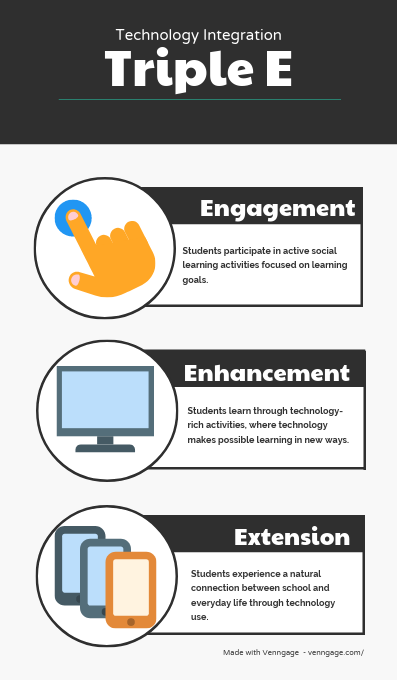OTAN News
Finally, Some Guidance! Using the Triple E Framework to Shape Technology Integration
Report from the Field
The journal article, Finally, Some Guidance! Using the Triple E Framework to Shape Technology Integration written by Susan Gaer and Kristi Reyes, documents the overall value of deliberately incorporating the Triple E structure with technology integration. This article serves as an overview of the research. Other articles will specifically focus on practical ways to integrate the Triple E Framework into classrooms.
What is the Triple E Framework?
Simply put, the Triple E Framework “focuses more on what students do with technology” (Gaer & Reyes, Fall 2022). The Triple E’s goal centers on ensuring that technology supports engagement, learning is enhanced and then extended by technology. Technology does not take the place of instruction. Hence, Engagement, Enhancement and Extension is the backbone of the Triple E Framework. The Triple E is described at length in Liz Kolb’s book, Learning First, Technology Second: An Educators Guide to Designing Authentic Lessons. The infographic below further explains the three descriptors (Kolb, 2017).

Using the Triple E Framework when planning lessons, decidedly creates a connection between learners, personalizes for different intelligences, and broadens learning into an authentic experience.
How to use the framework?
In summary, the framework is a four-step process listed here:
- Define the goals
- Select the appropriate technology tool
- Engage students to be active and social learners
- Connect student learning with real world tasks and contexts
There will be more examples of classroom application in articles to come.
Layers of Technology Integration
Also available is an A-F system for instructors which represents the different layers of technology integration. The “A” is the first layer with no technology integration. “For example, students are working on a fill-in-the-blank activity that the teacher printed out from the computer” (Gaer & Reyes, Fall 2022). Integration means learning happens with technology and printing out something from the computer does not align with the overarching goal of the Triple E Framework.
In contrast, a “C” is when a tool is selected to help solve a problem. This connects with “real” world context in that people use, for instance, Quick Books, to complete their taxes from home. It would not be helpful to use Kahoot for the IRS. The “C” layer identifies using technology in common sense ways that are helpful.
Resources that Support Evaluating Activities
The journal provides a user-friendly rubric designed for educators to evaluate the level of Engagement, Enhancement and Extension within a lesson or unit. Using observations, instructors answer each question with a yes, no, or somewhat response. These are then calculated with a yes answer receiving 2 points, somewhat 1 point and a no with zero. When added all together, the total score then fits into a green, yellow, or red category. Green earns the exceptional status, yellow meets 2 of the three levels, and red only reaches engagement and has the lowest level of integration.
Conclusion
The Triple E Framework aims to integrate technology thoughtfully and realistically into learning outcomes. Engagement should include collaboration with others while learning. Enhancement is a way to share learning with a portfolio or online presentation for instance. Lastly, extension requires student understanding of how to use the technology tool within their daily context.
Works Cited
Gaer, S., & Reyes, K. (Fall 2022). Finally, Some Guidance! Using the Triple E Framework to Shape Technology Integration. (J. D. Vanek, Ed.) Adult Literacy Education, 34-40. doi:http://doi.org/10.35847/SGaer.KReyes.4.3.34
Kolb, L. (2017). Learning first, technology second: An educator's guide to designing authentic lessons. Portland, Oregon: International Society for Technology in Education.

